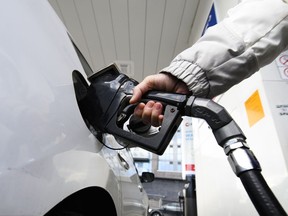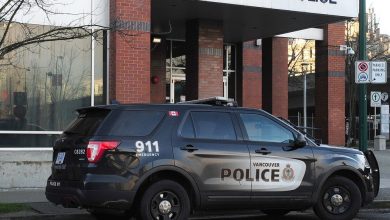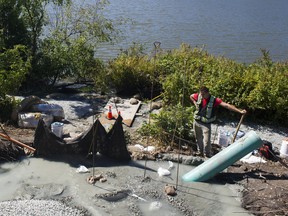Metro Vancouver gas: Here’s a breakdown of the prices at the pump

There’s the price of crude, retail and refinery costs and, of course, taxes

Article content
Metro Vancouver drivers are used to paying a lot at the pump. The cost of filling up got a bit more painful with the increase to the carbon tax, but there are plenty of other costs in play.
Gasoline, like any consumer product, has a supply chain. The price you pay at the pump is made up of crude oil, but also refining charges and lots of taxes that get distributed to many entities.
Advertisement 2
Article content
Article content
Here’s a breakdown of the cost of regular gas in Metro Vancouver based on the price of about $2.08 cents per litre:
READ MORE: Gas trip calculator: How much do you spend every day on fuel?
Taxes: 65 cents
Vancouver pays the highest gas taxes in Canada. This tax toll has risen steadily from 48 cents in 2016 to 60 cents in the first quarter of 2024, according to data from the B.C. Utilities Commission.
The taxes are comprised of:
• Motor fuel tax: 1.75 cents goes to provincial general revenue.
• Motor fuel tax: 6.75 cents goes to the B.C. Transportation Financing Authority, which is in charge of highways and other transportation infrastructure in the province.
• TransLink: 18.5 cents. This transit tax covers Metro north to Lions Bay, west including Bowen Island, south to the U.S.-Canada border, and east including Langley, Maple Ridge and Pitt Meadows. In Victoria, drivers pay their own transit tax of 5.5 cents a litre.
• Carbon tax: 17.61 cents. On April 1, 2024, the provincial carbon tax went up from $65 a tonne to $80 a tonne, which translated to an extra 3.3 cents a litre.
• Federal excise tax: 10 cents. The federal government charges a flat rate of 10 cents a litre, which has been frozen at this rate since 1995.
Article content
Advertisement 3
Article content
• GST: 9.9 cents. The five per cent federal Goods and Services Tax is charged on crude oil, refining and retailing costs, and the other taxes, which the Canadian Taxpayers Federation has criticized as a “tax-on-a-tax.”
Retail margin: 10 cents
This is the difference between the price at the pump, excluding taxes, minus the price that the gas station paid for the fuel.
Dan McTeague, president of the advocacy group Canadians for Affordable Energy, says the retail margin has been stable at around eight to 10 cents a litre for the last decade. And it isn’t much.
“If you’re charging eight cents a litre you better be selling a lot of gasoline and a lot of beef jerky,” he said.
Gas stations have also been under increasing pressure due to higher taxes, wages and energy costs, and they shoulder the cost of loyalty programs, where customers earn points when they fill up, he added.
“That’s really the last eight cents of competition. The other $2 is set.”
Refinery margin: 43.3 cents
This is the difference between the amount that a refinery pays for crude oil and the amount they sell their petroleum products on the wholesale market.
Advertisement 4
Article content
While the refinery amount seems huge, a significant chunk of that is due to the exchange rate.
Like all commodities, crude oil is priced in U.S. dollars whether they’re refined in Canada or elsewhere, said McTeague. If the Canadian dollar is trading at par with the U.S., the margin would be about 30 cents less.
Metro Vancouver gets about one-third of its fuel from Burnaby’s Parkland refinery, which produces about 55,000 barrels a day. About half to two-thirds of the region’s gas comes by rail and pipeline from Alberta, with a small percentage, on occasion, coming from U.S. refineries.
McTeague estimates the cost of transporting fuel through the Trans Mountain pipeline from Edmonton to the B.C. coast costs about three to seven cents per litre.
B.C. low-carbon fuel standard: 18 cents
B.C. drivers are also paying what is also known as a “second carbon tax,” which is buried in the wholesale price.
It’s a charge paid by fuel suppliers in B.C. who are required to buy carbon credits to meet the province’s low-carbon fuel requirements, said McTeague.
If you add it to other taxes, it would bring the total tax levy from 65 cents to 83 cents, or nearly 40 per cent of the total gasoline bill.
Advertisement 5
Article content
Crude oil prices: 71.5 cents
Fuelled by output cuts by OPEC, global economic growth and geopolitical events including conflicts in the Middle East, the price of crude oil hit US$85 a barrel on April 3, 2024, the highest since October.
x.com/cherylchan
Recommended from Editorial
-

Gas prices expected to surge to nearly $2.18 per litre by Friday: Analyst
-

As B.C.’s carbon tax goes up, here’s how you qualify for a rebate
Bookmark our website and support our journalism: Don’t miss the news you need to know — add VancouverSun.com and TheProvince.com to your bookmarks and sign up for our newsletters here.
You can also support our journalism by becoming a digital subscriber: For just $14 a month, you can get unlimited access to The Vancouver Sun, The Province, National Post and 13 other Canadian news sites. Support us by subscribing today: The Vancouver Sun | The Province.
Article content






